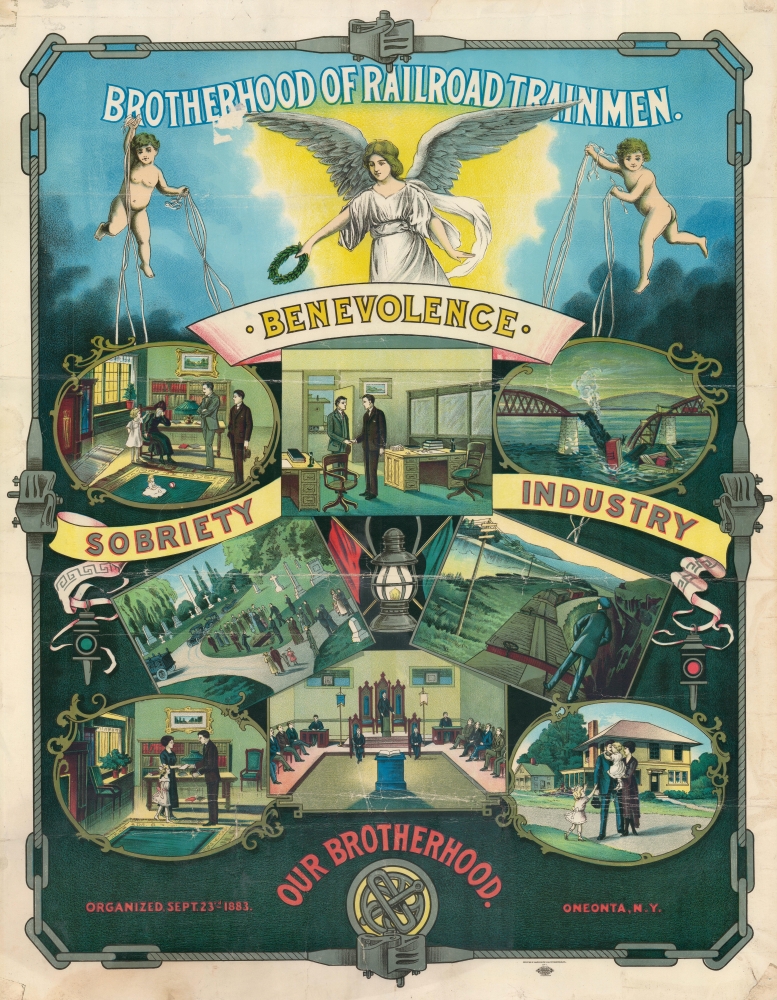This item has been sold, but you can get on the Waitlist to be notified if another example becomes available, or purchase a digital scan.
1915 Brotherhood of Railroad Trainmen Broadside
OurBrotherhood-amalgamatedlithographers-1915
Title
1915 (undated) 26 x 20.5 in (66.04 x 52.07 cm)
Description
A Closer Look
A sequence of eight images tells a story of a railway disaster resulting in the death of a rail worker, the company informing his widow, his being laid to rest, then remuneration for his family due to intervention from the union, and the start of a new life for the dead man's family (the Brotherhood of Railroad Trainmen was especially known for providing insurance to members' families in the event of their death on the job). An angel and cherubs appear at top, while banners state the union's motto: 'Benevolence, Sobriety, Industry.' Below, railroad signals and lanterns appear, along with the union's founding information. A border composed of chain links and railroad ties surrounds the image.The Brotherhood of Railroad Trainmen
The Brotherhood of Railroad Trainmen was founded in 1883 as the Brotherhood of Railroad Brakemen in Oneonta, New York, one of the earliest unions for rail workers in the country. By the early 20th century, it had grown substantially, relocated to Cleveland, Ohio, and taken on the name Brotherhood of Railroad Trainmen. Under President Alexander F. Whitney, a skilled and influential organizer, the union grew to over 300,000 members by the early 1930s and was close with the administration of Franklin D. Roosevelt.Before unions for rail workers existed, injuries and deaths on railroads were alarmingly high, with hundreds if not thousands of rail workers dying every year in crashes, bridge collapses, fires, and other mishaps throughout the country. In the late 19th century, it was America's deadliest major profession, even more dangerous for workers than mining.
Chromolithography
Chromolithography, sometimes called oleography, is a color lithographic technique developed in the mid-19th century. The process involved using multiple lithographic stones, one for each color, to yield a rich composite effect. Oftentimes, the process would start with a black basecoat upon which subsequent colors were layered. Some chromolithographs used 30 or more separate lithographic stones to achieve the desired product. Chromolithograph color could also be effectively blended for even more dramatic results. The process became extremely popular in the late 19th and early 20th centuries, when it emerged as the dominant method of color printing. The vivid color chromolithography produced made it exceptionally effective for advertising and propaganda imagery.Publication History and Census
This broadside was printed by the Republic Bank Note Company in Pittsburgh, Pennsylvania, a local affiliate of the Amalgamated Lithographers of America. Since the latter organization was only founded in 1915 and the former appears to have ceased to exist around 1918, it must date from the mid-late 1910s. Multiple printings of this broadside exist, identical except for the printer's logo at bottom-right; other examples are attributed to Goes and Quensel in Chicago and the Enterprise Litho. Co. in Cleveland, where the Brotherhood of Railroad Trainmen was headquartered. These variations may have been printed simultaneously in different cities. This broadside is not known to be held by any institution and is scarce to the market.CartographerS
Republic Bank Note Company (c. 1889 - 1918) was a printer based in Pittsburgh, Pennsylvania, that mostly produced works by local governments, labor unions, and masonic lodges. Late in its existence, it was registered with the union Amalgamated Lithographers of America as Local No. 24. More by this mapmaker...
Amalgamated Lithographers of America (1915 - present) is a union, formed from several preexisting unions dating back to 1886. Local unions for lithographers began to appear in the 1850s, but a national-level organization did not exist until the 1880s (the Lithographers' International Protective and Beneficial Association of the United States and Canada, an offshoot of the Knights of Labor). But this and other unions found only limited success, in part because they did not admit lesser-skilled workers in the printing process, such as press feeders. Thus, in 1915 the Amalgamated Lithographers of America was formed from a combination of four existing unions, with two others joining later. The organization has gone through several mergers and reorganizations since, but still exists today. Learn More...

